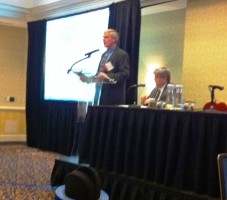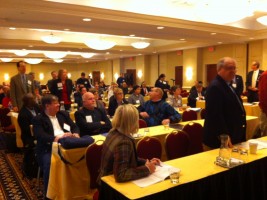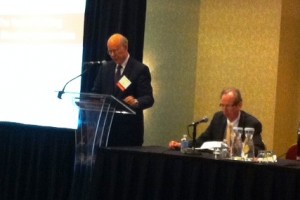2011
USDA ARS 1st International Biosafety and Biocontainment Symposium
February 6-9, 2011
These program items below have slides which are available for download as PDFs.
Preconference Courses
Sunday, February 6, 2011
8:00 am – 12:00 pm
#1 Commissioning & De-commissioning, Operational Models
Diana Whipple, MS, United States Department of Agriculture, Agricultural Research Services, Ames, IA
Giles Tremblay, Merrick & Company, Kanata, Ontario, Canada
Christian Griot, DVM, PhD, Institute of Virology and Immunoprophylaxis, Switzerland
This course will provide a basic overview of the life cycle of containment facilities and will focus on commissioning, operating and decommissioning of the facilities. Participants will develop an understanding of the commissioning process and how to use the information that is generated. Participants also will develop an understanding of the distinction between commissioning facilities and having the facilities ready for full operations. Information will be presented on important aspects of operating containment facilities and on factors that need to be considered when decommissioning facilities.
Objectives:
- Understand the purpose of commissioning facilities and how to use the information
- Understand the distinction between commissioning facilities and having them ready for full operation
- Learn about important aspects of operating containment facilities
- Become familiar with factors that need to be considered when decommissioning containment facilities
Target Audience: Building Managers, Program Managers and Directors, Biosafety Officers
Audience Level: Basic, Intermediate
1:00 pm – 5:00 pm
#2 Carcass Disposal & Effluent Decontamination
Joe Wilson, Bio-Response Solutions, Inc., Pittsboro, IN
Paul Langevin, Merrick & Company, Kanata, Ontario, Canada
This course will teach how to size and select from the 6 different types of effluent decontamination systems (EDS), the pros and cons of each different type of system, which are applicable to the different types of biocontainment facilities, and which types not to consider for certain types of facilities. Infrastructure and cost considerations will be discussed in detail. Examples of successful implementations will be reviewed with photos and discussions.
Animal biocontainment facilities often face handling and disposal issues for carcass materials. The advent of alkaline hydrolysis and rendering technologies gave facility designers additional tools to consider for interface of more desirable disposal methods with the barrier. This course will also teach what types of systems are available including low and high temperature alkaline hydrolysis systems, rendering systems, pros and cons of each, and how to plan facilities for these newer technologies and how to interface the technologies with the barrier, infrastructure considerations, cost considerations, and final effluent or solids disposal considerations that may be factors in the selection of the system. Examples of implementations will be reviewed with photos and discussions.
Objectives:
- Learn all about the different types of EDS systems, how to properly select and size them, how they compare in acquisition and operational cost, and what infrastructure requirements are necessary for implementation, operation and ongoing maintenance of these systems and facilities.
- Biosafety considerations in owning, operating, and maintaining the different types of systems.
- Learn all about the different types of carcass disposal technologies, how to properly select and size them, how they compare in acquisition and operational cost, what infrastructure requirements are necessary for implementation, operation, and ongoing maintenance of these systems, and what issues need to be considered for final disposal of the effluents from these systems.
- Biosafety considerations in owning, operating, and maintaining the different types of systems.
Suggested Background: Familiarity with educational documents or planning guides available from producers of EDS and carcass disposal systems producers; Facility Design Handbooks such as the International Veterinary Biosafety Workgroup Handbook.
Target Audience: (Biocontainment) Facility designers, facility administrators, bio-safety professionals, animal facility personnel, and facility maintenance personnel
Audience Level: Basic, Intermediate, and Advanced
8:00 am – 12:00 pm
#3 Agricultural Animal Welfare Issues in Research
Cancelled.
1:00 pm – 5:00 pm
#4 High Consequence Livestock Pathogens
Robert Heckert, DVM, Robert Heckert Consulting, LLC, Bowie, MD
William White, United States Department of Agriculture, Animal and Plant Health Inspection Services, Greenport, NY
This is an introductory course to high consequence livestock pathogens. This course will briefly review the importance of livestock diseases, provide an overview of several of the more important livestock diseases and discuss the biocontainment issues related to each.
Objectives
- Understand the importance of livestock pathogens
- Learn the microbiology, disease expression and epidemiology of several high consequence livestock pathogens
- Understand the biocontainment required to work with high consequence livestock pathogens
Suggested Background: Basic microbiology and biosafety
Target Audience: Biosafety professionals, animal caretakers, researchers, and anyone wanting to work with agricultural animals infected with high consequence livestock pathogens.
Audience Level: All levels
8:00 am – 12:00 pm
#5 BSL-3 Ag: “The Good, The Bad, & The Ugly”
(Work Practices, Safeguards & Risk Management)
Scott Rusk, Director, Pat Roberts Hall, Kansas State University
Julie Johnson, Assistant Vice President for Research Compliance and Biosafety Officer, Biosecurity Research Institute, Kansas State University
Mark Minihan, Animal Suite Supervisor, Biosecurity Research Institute, Kansas State University
Hao Vu, Biosafety Specialist, Biosecurity Research Institute, Kansas State University
This course will encompass comprehensive BSL-3Ag animal project management and planning strategies to include course exercises and class participation. Emergency response considerations, equipment needs, personal protective equipment options, physical injury recognition and prevention, occupational health program, entry and exit protocols, approaches to worker training, integration of research goals, and waste management and decontamination are course subject materials. Primary learning objectives and outcomes include understanding methods and approaches for BSL-3Ag operations and management and to identify distinct workplace hazards and associated risk mitigation.
Objectives:
- Identify unique aspects of BSL-3Ag biocontainment
- Understand work hazard assessment and risk mitigation steps for large animal work.
- Apply emergency response scenarios in your institution
Suggested Bkg: Combined experience in biocontainment fundamentals; BSL-3, ABSL-3, and BSL-3Ag
Target Audience: Animal Care, Biosafety Officers, Lab Animal Veterinarians, Animal Facility Managers, Animal Suite Supervisors, Researchers, Research Technicians, Veterinary Technicians
Audience Level: Intermediate to Advanced
1:00 pm – 5:00 pm
#6 Introduction to Large Animal Biosafety
Robert Ellis, PhD, CBSP, Colorado State University, Fort Collins, CO
Joseph Kozlovac, MS, RBP, CBSP, United States Department of Agriculture, Agricultural Research Services, Beltsville, MD
Objectives:
- Describe the need for risk assessments
- Discuss measures for improving overall safety training, PPE, administrative measures, and Engineering
- Know the difference of Public Health Risk vs. Agricultural Risk
- Differences in ABSL-2, ABSL-3, and ABSL-3 AG
- How to adapt facilities for different species

Steven Kappes, PhD, United States Department of Agriculture, Agricultural Research Services, Beltsville, MD
Conference Program
Sunday, February 6, 2011
5:30 – 7:00 pm Opening Reception in Exhibit Hall
Monday, February 7, 2011
7:00 am – 6:00 pm Registration
9:00 am – 4:00 pm Exhibits
7:30 – 7:45am Welcome – Joseph Kozlovac, MS, RBP, CBSP, Steven Kappes, PhD, United States Department of Agriculture, Agricultural Research Services, Beltsville, MD
7:45 – 11:30 pm
Session I: Agriculture Research Infrastructure Challenges
Moderator: Joseph Kozlovac, MS, RBP, CBSP, United States Department of Agriculture, Agricultural Research Services, Beltsville, MD
7:45 – 8:35am Agricultural Infrastructure Challenges – Keynote Speaker –
Jerry Jaax, DVM, Associate Vice President, Research Compliance, Kansas State University, Manhattan, KS

Jerry Jaax, DVM, Associate Vice President, Research Compliance, Kansas State University, Manhattan, KS
8:35 – 9:05am Defining ABSL3 and BSL3 AG(PDF 1.36MB) –
Robert Heckert, DVM, Robert Heckert Consulting, LLC, Bowie, MD
9:05 – 9:35am Operation & Maintenance Challenges at Plum Island(PDF 717KB) –
James Johnson, MS, MBA, Department of Homeland Security, Washington, DC
9:35 – 9:55am Break in Exhibit Hall
9:55 – 10:25am Achieving Biocontainment in Developing Countries –
Nicoletta Previsani, PhD, World Health Organization, Geneva, Switzerland
10:25 – 11:30pm Session I Roundtable – Agricultural Infrastructural Challenges: Research, Production, and Vaccine Production Diagnostic Challenges
Moderator: Prem Paul, DVM, PhD, University of Nebraska, Lincoln, NE
Panelists: Bruce Stewart-Brown, DVM, Perdue Farms, Inc., Salisbury, MD; Martin Kuster, MD, Novartis International AG, Basel, Switzerland; David Swayne, Southeast Poultry Research Laboratory, Athens, GA
Composting of Carcasses: Biosafety Issues and Solutions(PDF 1.08MB) – Martin Kuster, MD MOH
Biosecurity Risk Assessment For Growout Farms (not just an AI talk)(PDF 3.43MB) – Bruce Stewart-Brown, DVM, dipl ACPV
11:30 – 1:00pm Lunch in Exhibit Hall
1:00 – 2:30pm
SPECIAL SESSION
Moderator: Jim Welch, Elizabeth R Griffin Foundation, Kingsport, TN
1:00 – 2:00pm United States Senator Pat Roberts, State of Kansas
2:00 – 2:30pm Under Secretary Catherine E. Woteki, PhD, United States Department of Agriculture,
Washington, DC
2:30 – 6:30pm
Session II: Risks in Research and Field Work
Moderator: Robert Ellis, PhD, CBSP, Colorado State University, Fort Collins, CO
2:00 – 2:30pm Porcine Reproductive and Respiratory Syndrome (PRRS): Science, Application, & Risk Assessment(PDF 1.72MB) –
Scott Dee, DVM, PhD, University of Minnesota, St. Paul, MN
2:30 – 3:00pm Wildlife, Livestock, and Human Interface –
Steve Olsen, DVM, PhD, United States Department of Agriculture, Agricultural Research Services, Ames, IA
3:00 – 3:30pm H1N1 Response –
Amy Vincent, DVM, PhD, National Animal Disease Center, Ames, IA
4:00 – 4:30 pm Break in Exhibit Hall
4:00 – 4:30pm Avian Influenza(PDF 7.44MB) –
Kristy Pabilonia, DVM, DACVM, Colorado State University, Fort Collins, CO
4:30 – 5:00pm Risk Communication(PDF 2.12MB) –
Sean Kaufman, MPH, CHES, CPS, Emory University, Atlanta, GA
5:00 – 6:00pm Session II Roundtable – Agricultural Research in the Lab and Field: Risk Assessment Practices
Moderator: Sean Kaufman, MPH, CHES, CPS, Emory University, Atlanta, GA
Presenters: Jonathan Zack, DVM, United States Department of Agriculture, Animal and Plant Health Inspection Services, Robbinsville, NJ; Christian Griot, DVM, PhD, Institute of Virology and Immunoprophylaxis, Switzerland; William White, DVM, United States Department of Agriculture, Animal and Plant Health Inspection Services, Greenport, NY
From the Field to the Laboratory(PDF 3.05MB) – Kathrin Summermatter, Urs Pauli, Christian Griot
Tuesday, February 8, 2011
7:00 am – 6:00 pm Registration
9:00 am – 3:30 pm Vendor Exhibits
8:00 – 12:00 pm
Session III: Regulatory Changes and Response
Moderator: Paul Meechan, PhD, RBP, CBSP, Centers for Disease Control and Prevention, Atlanta, GA
8:00 – 8:30 pm The Capabilities of the National Animal Health Laboratory Network –
Tammy Beckham, PhD, DVM, Texas Veterinary Medical Diagnostic Laboratory, Texas A&M University, College Park, TX
8:30 – 9:00 am Updates to Select Agent Regulation –
Freeda Isaac, DVM, United States Department of Agriculture, Animal and Plant Health Inspection Services, Beltsville, MD
9:00 – 9:30 am Dual Use Issues – Caird Rexroad, PhD, United States Department of Agriculture,
Agricultural Research Services, Washington, DC
9:30 – 10:00 am Import/Export Practices & Permitting – Jodie Kulpa-Eddy, DVM, United States Department of Agriculture, Washington, DC
10:00 – 10:15 am Break in Exhibit Hall
10:15 – 10:45 am Self-audit of Biosafety Practices/Process for Research Facilities(PDF 5.34MB) –
Hao Vu, MS, Biosecurity Research Institute, Kansas State University, Manhattan, KS
10:45 am – 12:00 pm Session III Roundtable–Potential Changes in Biorisk Policy
Moderator: Robert Hawley, PhD, RBP, CBSP, Midwest Research Institute, Frederick, MD
Panelists: David Franz, DVM, PhD, Midwest Research Institute, Frederick, MD; Mary Cipriano, MBA, CBSP, RBP, SM(NRCM), Abbott Diagnostics, Abbott Park, IL; Steve Copping, DVM, Pirbright Laboratory, Pirbright, Surrey, GU; Lisa Young, Canadian Food Inspection Agency, Ottawa, ON, Canada
Introduction(PDF 17KB) – Robert J. Hawley, Ph.D., RBP, CBSP
Potential Changes in Biorisk Policy, UK Perspective(PDF 222KB) – Steve Copping
BioRisk Policy: in a global biotech revolution(PDF 1.34MB) – David R. Franz
Canadian Biosafety Standards and Guidelines(PDF 361KB) – Lisa Young
12:00 – 1:30 pm Lunch in Exhibit Hall
1:30 – 4:00 pm
Session IV: Aquaculture
Moderator: Jeff Silverstein, PhD, United States Department of Agriculture, Agricultural Research
Services, Beltsville, MD
1:30 – 2:00 pm Implementing, Auditing & Certifying Veterinary Biosecurity Programs in Aquaculture Operations(PDF 3.34MB) – David Scarfe, PhD, DVM, American Veterinary Medical Association,
Schaumburg, IL
2:00 – 2:30 pm Biosecurity in Water Recirculation Aquaculture Systems(PDF 1.54MB) – Christopher Good,
DVM, PhD, Freshwater Institute, Shepherdstown, WV
2:30 – 3:00 pm Development of a Aquaculture Disease Diagnostic Network – Jill Rolland, United States Department of Agriculture, Animal and Plant Health Inspection Service, Riverdale, MD
3:00 – 3:30 pm Break
3:30 – 4:00 pm Containment Standards for Facilities Handling Aquatic Pathogens(PDF 311KB) –
Lisa Young, Canadian Food Inspection Agency, Ottawa, Ontario, Canada
4:00 – 5:30 pm
Session V: Arthropods
Moderator: David Bressler, CBSP, Centers for Disease Control and Prevention, Atlanta, GA
4:00 – 4:30 pm International Challenges Related to Arthropod Containment – Dan Strickman,
United States Department of Agriculture, Agricultural Research Services, Beltsville, MD
4:30 – 5:00 pm Working Safely with Rift Valley Fever(PDF 3.66MB) – Mike Turell, PhD, United States Army
Medical Research Institute of Infectious Diseases, Fort Detrick, MD
5:00 – 5:30 pm Emergence of Exotic Blue Tongue(PDF 7.59MB) – Uwe Mueller-Doblies, Dr. Med. Vet, Institute for Animal Health, Pirbright Laboratory, Pirbright, Surrey, England
6:30 – 10:00 pm Banquet in Hotel – Special performance by David G. Willey, MPhys, University of Pittsburgh,
Johnstown, PA, frequent special guest and “Mad Scientist” featured on the Jay Leno Show.
Wednesday, February 9, 2011
7:00 am – 1:00 pm Registration
8:00 – 12:00 pm
Session VI: One Health
Moderator: Lonnie King, DVM, Ohio State University, Columbus, OH
8:00 – 8:50 am One Health – Keynote Speaker(PDF 2.98MB) – Laura H Kahn, MD, MPH, MPP, Princeton University, Princeton, NJ
8:50 – 9:20 am NBAF Project Update(PDF 1.20MB) – Michelle Colby, DVM, Department of Homeland Security, Washington, DC
9:20 – 9:50 am Applications of One Health(PDF 502KB) – Mo Salman, BVMS, MPVM, PhD, DACVPM, Colorado State University, Fort Collins, CO
9:50 – 10:20 am The OIE Laboratory Twinning Program – Opportunities for a One Health Approach(PDF 683KB) –
Kate Glynn, DVM, MPVM, World Health Organization, Paris France
10:20 – 10:35 am Break
10:35 – 11:05 am Use of Forensics Laboratories in Outbreaks – Neel Barnaby, FBI Laboratory, Quantico, VA
11:05 – 12:30 pm Session VI Roundtable/Panel – One Health Realities & Solutions
Moderator: Lonnie King, DVM, Ohio State University, Columbus, OH
Panelists: Mo Salman, PhD, DACVPM, Colorado State; University, Fort Collins, CO; Kate Glynn, DVM, World Health Organization, Paris France; Laura H. Kahn, MD, Princeton University, Princeton, NJ; TBD
“One Health” Realities and Solutions(PDF 446KB) – Kate Glynn DVM, MPVM
12:30 pm Closing Comments & Adjourn – Joe Kozlovac, MS, RBP, CBSP, United States Department of
Agriculture, Agricultural Research Services, Beltsville, MD


